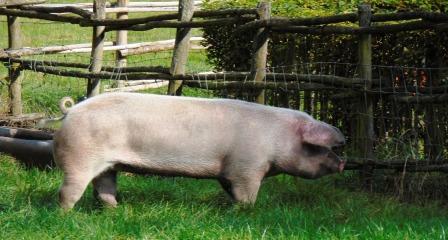A piggy (bank) eats everything. And if you then need it, there is winter stock.
Pigs can plow and rooting, process waste, produce manure, meat and fat.
They are omnivores that make the tastiest meat of the cheapest forage. Everything that was somewhat edible went to the pigs. Dishwashing you do e.g. (first) without soap with pure hot water, which then enters the pig bucket, like cooking water from potatoes, vegetables and rice, whey, and all food scraps.
 Slop: flour with water, milk or milk products mixed as forage for (diseased) farm animals.
Slop: flour with water, milk or milk products mixed as forage for (diseased) farm animals.
Swill is as pigfood cooked kitchen waste and leftovers. It spoils quickly. Use it immediately and do not retain it.
The common domestic pig (Sus (scrofa) domesticus) can be 12 to 13 years old but is 4 to 6 months, and about 100 to 115 kg when ripe for slaughtering.
A young pig is a piglet, a female a sow and a male bear.
The sow is approximately 115 days (3 months, 3 weeks and 3 days) pregnant and has been selected to receive up to 20 (average 11 to 13) piglets per litter. Usually, there are fences provided around the sow, where the piglets can underneath. This is to prevent the mother to lie down on them and suffocate them.
There is fierce competition in a litter for any big nipple at the front of the sow, as it gives the most milk.
Weaning occurs between 21 and 28 days after birth, on organic farms after 42 days.
The Pietrain (with black spots) is a pig that excels in high percentages of meat and is economical in feed. A pig transfers about 35% of its food into meat.
Pigs are highly intelligent. (Look in politics.) Previously they were often trained for circus tricks. And (still) to detect truffles with their great nose.
Pigs are intelligent and social animals. If they have enough space, they are also very clean.
In the summer they like to take a mud bath to cool. They have no sweat glands to regulate their body temperature nor does their small hair gives sunscreen! By a mud bath they get rid of body heat and parasites.
Previously pigs were sometimes pierced a ring or staple through the nose against the rooting. And so they could not root through under a fence. Without a ring you can use them as a plough on harvested field or for tearing pasture. A few tubers or roots hided in the ground, and they plow everything. They pick up the last potatoes from a harvested field.
You can also use them to clean up fallen fruit in an orchard. Besides weeds they eat snails, if you learn them by doing some with the feed. (They would have a lot of extra water needed for their digestion.)
When pigs always have enough free range they keep their stable very clean and tidy (really not a 'pigsty '!).
Before the 15th century branded pigs were released into the woods to look for their food themselves. Even in cities were branded boars along the streets.
Distressing is: that in our breeding, pigs are housed and fed better than the people in the countries where the feed comes from.
The Menapian pig
Around 200 BC the Roman statesman Cato (234 - 149 BC) wrote that 3 to 4,000 hams and side pieces of pigs from 'Belgica' were stored in the cellars of Italy as stock. Historian Pliny the Elder (23-79 CE) wrote that the hams of the Menapian pig were wanted and sold on the markets of Rome. A very appreciated regional specialty.
From 500 years before Christ until the middle of the 18th century the Celtic pig was used in Belgica. As an 'Iberian pig' it lives on in Spain and it still produces the best ham in the world: pata negra.
Thanks to Ghent University, butcher Hendrik Dierendonck and pig breeder Ruben Brabant "the Menapian pig” has been re-cultivated.
Nipples or teats in mammals
Mammary glands are evolutionarily evolved from sweat glands. Almost all mammals (except the platypus) have nipples, males as well as females.
Nature seems safe side always to give mammalian one or two nipples extra (above the average litter size) as a backup.
A wild boar has 12 nipples. A tame pig has 12, 13 or 14 and sometimes even 22 nipples. Of these, there are usually only 14 productive. The average litter size is 12, but can go up to 18. Growers have selected for years on productivity.
Piglets conquer immediately after birth for ‘their’ teat that they never give up, the heaviest piglets lying in front of the best weaning. They do not 'change'.
Domestic rabbits have 8 to 10 nipples, and litters that also by human selection, can be up to 12 or 14.
"There is almost no cleaner animal than a pig. It is the man who makes the pig a pervert by limiting living space."(John Van Dam)
A man wearing a pig on his shoulders. "Hello, played keno I guess?” "Yes.” says the pig. (JW Besouw)
Baptist proudly displays a photograph in which he poses between his pigs. "This one in the middle, that's me! “(JW Besouw)
